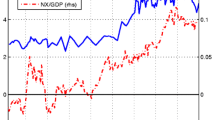Abstract
Exchange Rate Expectations and Foreign Direct Investment Flows. — Theories about exchange rate expectations are difficult to check empirically. We study FDI data to find indirect evidence on the formation of exchange rate expectations by foreign direct investors. Using panel data techniques on exchange rate movements and FDI flows from the United States to 20 OECD countries we find that skewness of devaluations has a robust positive impact on FDI flows while average devaluation and its volatility do not. We view this evidence as consistent with the hypothesis that relatively large exchange rate movements generate mean-reverting long-run expectations. This finding is consistent with survey-based evidence on exchange rate expectations.
Similar content being viewed by others
References
Aizenman, J. (1992). Exchange Rate Flexibility, Volatility, and Domestic and Foreign Direct Investment.IMF Staff Papers 39 (4): 890–922.
Ball, L., and N. Mankiw (1995). Relative Price Changes as Aggregate Supply Shocks.Quarterly Journal of Economics 110(1): 161–193.
Blonigen, B. (1997). Firm-Specific Assets and the Link between Exchange Rates and Foreign Direct Investment.American Economic Review 87 (3): 447–465.
Campa, J. M. (1993). Entry by Foreign Firms in the United States under Exchange Rate Uncertainty.Review of Economics and Statistics 75 (4): 614–622.
Caves, R. E. (1989). Exchange Rate Movements and Foreign Direct Investment in the United States. In D. Audretsch and M. Claudon (ed.),The Internationalization of US Markets. New York: New York University Press.
Cushman, D. (1985). Real Exchange Rate Risk, Expectations, and the Level of Direct Investment.The Review of Economics and Statistics 67 (2): 297–308.
Cushman, D. (1988). Exchange Rate Uncertainty and Foreign Direct Investment in the United States.Weltwirtschaftliches Archiv 124 (2): 322–336.
Dominguez, K. (1986). Are Foreign Exchange Forecasts Rational? New Evidence from Survey Data.Economic Letters 21 (3): 277–281.
Dixit, A. (1989a). Hysteresis, Import Penetration and Exchange Rate Pass-Through.Quarterly Journal of Economics 104 (2): 205–228.
Dixit, A. (1989b). Entry and Exit Decisions under Uncertainty.Journal of Political Economy 97 (3): 620–638.
Engel, C. (1996). The Forward Discount Anomaly and the Risk Premium: A Survey of the Recent Evidence.Journal of Empirical Finance 3 (2): 123–192.
Engel, C., and J. Hamilton (1990). Long Swings in the Dollar: Are They in the Data and Do Markets Know It?American Economic Review 80 (4): 689–713.
Frankel, J., and K. Froot (1987). Using Survey Data to Test Standard Propositions regarding Exchange Rate Expectations.American Economic Review 77 (1): 133–153.
Frankel, J., and K. Froot (1989). Interpreting Tests of Forward Discount Bias Using Survey Data on Exchange Rate Expectations.Quarterly Journal of Economics 104 (1): 139–161.
Froot, K., and J. Stein (1991). Exchange Rates and Foreign Direct Investment: An Imperfect Capital Markets Approach.Quarterly Journal of Economics 106 (4): 1191–1217.
Goldberg, L., and C. Kolstad (1995). Foreign Direct Investment, Exchange Rate Variability and Demand Uncertainty.International Economic Review 36 (4): 855–873.
Greene, W. H. (1997).Econometric Analysis. Upper Saddle River, NJ: Prentice-Hall.
Hartman, D. (1979). Foreign Investment and Finance with Risk.Quarterly Journal of Economics 93 (2): 213–232.
Hodrick, R.(1987).The Empirical Evidence on the Efficiency of Forward and Futures Foreign Exchange Markets. London: Harwood.
Healy, P., and K. Palepu (1993). International Corporate Equity Associations: Who, Where and Why? In K. Froot (ed.),Foreign Direct Investment. Chicago: University of Chicago Press.
Hsiao, C. (1986).Analysis of Panel Data. Cambridge: Cambridge University Press.
IMF (various issues).International Finance Statistics Yearbook. Washington, D.C.
Itagaki, T. (1981). The Theory of the Multinational Firm under Exchange Rate Uncertainty.Canadian Journal of Economics 14 (2): 276–297.
Klein, M., and E. Rosengren (1994). The Real Exchange Rate and Foreign Direct Investment in the United States: Relative Wealth vs. Relative Wage Effects.Journal of International Economics 36 (3/4): 373–389.
Kohlhagen, S. (1977). Exchange Rate Changes, Profitability and Direct Foreign Investment.Southern Economic Journal 44 (1): 43–52.
Longin, F. (1997). The Threshold Effect in Expected Volatility: A Model Based on Asymmetric Information.Review of Financial Studies 10 (3): 837–869.
MacDonald, R. (2000). Is the Foreign Exchange Market ‘Risky’? Some New Survey-Based Results.Journal of Multinational Financial Management 10 (1): 1–14.
McCulloch, R. (1989). Japanese Investment in the United States. In D. Audretsch and M. Claudon (ed.),The Internationalization of U. S. Markets. New York: New York University Press.
Obstfeld, M., and K. Rogoff (1996).Foundations of International Macroeconomics. Cambridge, Mass.: MIT Press.
OECD (various issues).International Direct Investment Yearbook. Paris.
Ray, E. (1989). The Determinants of Foreign Direct Investment in the United States 1979-85. In R. Feenstra (ed.),Trade Policy for International Competitiveness. Chicago: University of Chicago Press.
Rogoff, K. (1996). The Purchasing Power Parity Puzzle.Journal of Economic Literature 34 (2): 647–668.
Stevens, G. (1992). Exchange Rates and Foreign Direct Investments: A Note. International Finance Paper 444. Board of Governors of the Federal Reserve System, Washington D. C.
Swenson, D. (1994). Impact of U. S. Tax Reform on Foreign Direct Investment in the United States.Journal of Public Economics 54 (2): 243–266.
Takagi, S. (1991). Exchange Rate Expectations: A Survey of Survey Studies.IMF Staff Papers 38 (1): 156–183.
About this article
Cite this article
Chakrabarti, R., Scholnick, B. Exchange rate expectations and foreign direct investment flows. Weltwirtschaftliches Archiv 138, 1–21 (2002). https://doi.org/10.1007/BF02707321
Issue Date:
DOI: https://doi.org/10.1007/BF02707321




